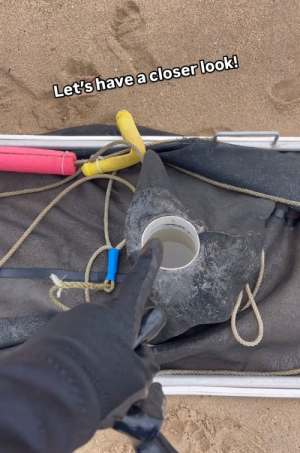Aussies spot fatal beach danger hiding in plain sight: 'Do not risk your life'
By
Gian T
- Replies 2
What began as a long-awaited escape on the open water quickly took a devastating turn for an Australian couple.
The scenic voyage, meant to offer rest and joy, became an unforgettable experience for all the wrong reasons.
Loved ones are now left grappling with unanswered questions and profound sorrow.
The serene beauty of the ocean can often lull beachgoers into a false sense of security, leading to what lifeguards term 'complacency'.
This complacency can have fatal consequences, as the box jellyfish, known for its potent venom, lurks in the coastal waters during this time of year.
'We are coming up to the time of year where lifeguards unfortunately start to see people becoming complacent and swim outside the netted areas,' Far North Queensland Lifesavers warned.
'On a calm day, box jellyfish can be found right along the water's edge, feeding on shrimp and bait fish. Do not risk your life.'
To illustrate the point, Far North Queensland Lifeguards shared a video on social media showing a bucket of ocean water teeming with juvenile shrimp and krill—the perfect feeding ground for box jellyfish.
This visual evidence serves as a chilling reminder of the favourable conditions in which these dangerous creatures thrive.
Dr Lisa-ann Gershwin, Director of the Australian Marine Stinger Advisory Services and a renowned jellyfish expert, has emphasised the severity of the threat by stating that the box jellyfish has 'earned' its title as the world's most venomous animal.
These creatures are not confined to a single region; they inhabit tropical coastal waters along Australia's northern coastline, from Western Australia to Queensland, and remain active until the seas calm in late May.
Despite a reported decline in box jellyfish numbers around Cairns, attributed to the aftermath of 2023's Ex-Tropical Cyclone Jasper, these creatures are still being encountered further south.
A routine check at Eimeo Beach in Mackay captured eight box jellyfish in January alone.
The history of box jellyfish encounters is grim, with at least 70 known deaths in Australian waters since records began in the 1880s, according to Australian Geographic.
In recent years, Far North Queensland has mourned the loss of two young individuals due to box jellyfish stings.
The anatomy of the box jellyfish is as fascinating as it is frightening.
With about 60 venomous tentacles that can stretch up to three metres, victims can quickly become entangled, leading to severe stings that have been likened to electrocution or the sensation of hot oil mixed with vinegar on the skin.
Immediate treatment is crucial, and vinegar is vital in this process.
'Vinegar neutralises the stinging cells from injecting more venom into your skin, and you want to stop every single one possible,' Dr Gershwin explained.
'If you're over the lethal sting threshold, it isn't going to do anything. But the thing is, you're not going to know in the moment, so you need to flood the area with vinegar and seek medical assistance as quickly as possible.'
As we enjoy the beauty and recreation our beaches offer, it's imperative to remain vigilant and respect the power of nature.
Continuously swim within the safety of netted areas, heed the advice of lifeguards, and be prepared to act quickly in case of a jellyfish sting.
Credit: Instagram

Have you taken steps to stay safe from marine stingers before swimming during jellyfish season? Do you know how to respond if someone gets stung by a box jellyfish near you? Let us know in the comments below.
The scenic voyage, meant to offer rest and joy, became an unforgettable experience for all the wrong reasons.
Loved ones are now left grappling with unanswered questions and profound sorrow.
The serene beauty of the ocean can often lull beachgoers into a false sense of security, leading to what lifeguards term 'complacency'.
This complacency can have fatal consequences, as the box jellyfish, known for its potent venom, lurks in the coastal waters during this time of year.
'We are coming up to the time of year where lifeguards unfortunately start to see people becoming complacent and swim outside the netted areas,' Far North Queensland Lifesavers warned.
'On a calm day, box jellyfish can be found right along the water's edge, feeding on shrimp and bait fish. Do not risk your life.'
To illustrate the point, Far North Queensland Lifeguards shared a video on social media showing a bucket of ocean water teeming with juvenile shrimp and krill—the perfect feeding ground for box jellyfish.
This visual evidence serves as a chilling reminder of the favourable conditions in which these dangerous creatures thrive.
Dr Lisa-ann Gershwin, Director of the Australian Marine Stinger Advisory Services and a renowned jellyfish expert, has emphasised the severity of the threat by stating that the box jellyfish has 'earned' its title as the world's most venomous animal.
These creatures are not confined to a single region; they inhabit tropical coastal waters along Australia's northern coastline, from Western Australia to Queensland, and remain active until the seas calm in late May.
Despite a reported decline in box jellyfish numbers around Cairns, attributed to the aftermath of 2023's Ex-Tropical Cyclone Jasper, these creatures are still being encountered further south.
A routine check at Eimeo Beach in Mackay captured eight box jellyfish in January alone.
The history of box jellyfish encounters is grim, with at least 70 known deaths in Australian waters since records began in the 1880s, according to Australian Geographic.
In recent years, Far North Queensland has mourned the loss of two young individuals due to box jellyfish stings.
The anatomy of the box jellyfish is as fascinating as it is frightening.
With about 60 venomous tentacles that can stretch up to three metres, victims can quickly become entangled, leading to severe stings that have been likened to electrocution or the sensation of hot oil mixed with vinegar on the skin.
Immediate treatment is crucial, and vinegar is vital in this process.
'Vinegar neutralises the stinging cells from injecting more venom into your skin, and you want to stop every single one possible,' Dr Gershwin explained.
'If you're over the lethal sting threshold, it isn't going to do anything. But the thing is, you're not going to know in the moment, so you need to flood the area with vinegar and seek medical assistance as quickly as possible.'
As we enjoy the beauty and recreation our beaches offer, it's imperative to remain vigilant and respect the power of nature.
Continuously swim within the safety of netted areas, heed the advice of lifeguards, and be prepared to act quickly in case of a jellyfish sting.
Credit: Instagram
Key Takeaways
- Lifeguards in Far North Queensland are warning beachgoers about the danger of box jellyfish, especially during the Easter holidays.
- Box jellyfish are currently fully grown and can be found feeding right along the water's edge outside of netted areas, posing a significant risk to swimmers.
- Despite a decline in numbers around Cairns, box jellyfish continue to be a threat, with lifeguards still catching them further south at places like Mackay.
- Vinegar is an essential first aid measure for box jellyfish stings, as it neutralises the stinging cells from injecting more venom, yet immediate medical assistance is crucial.








